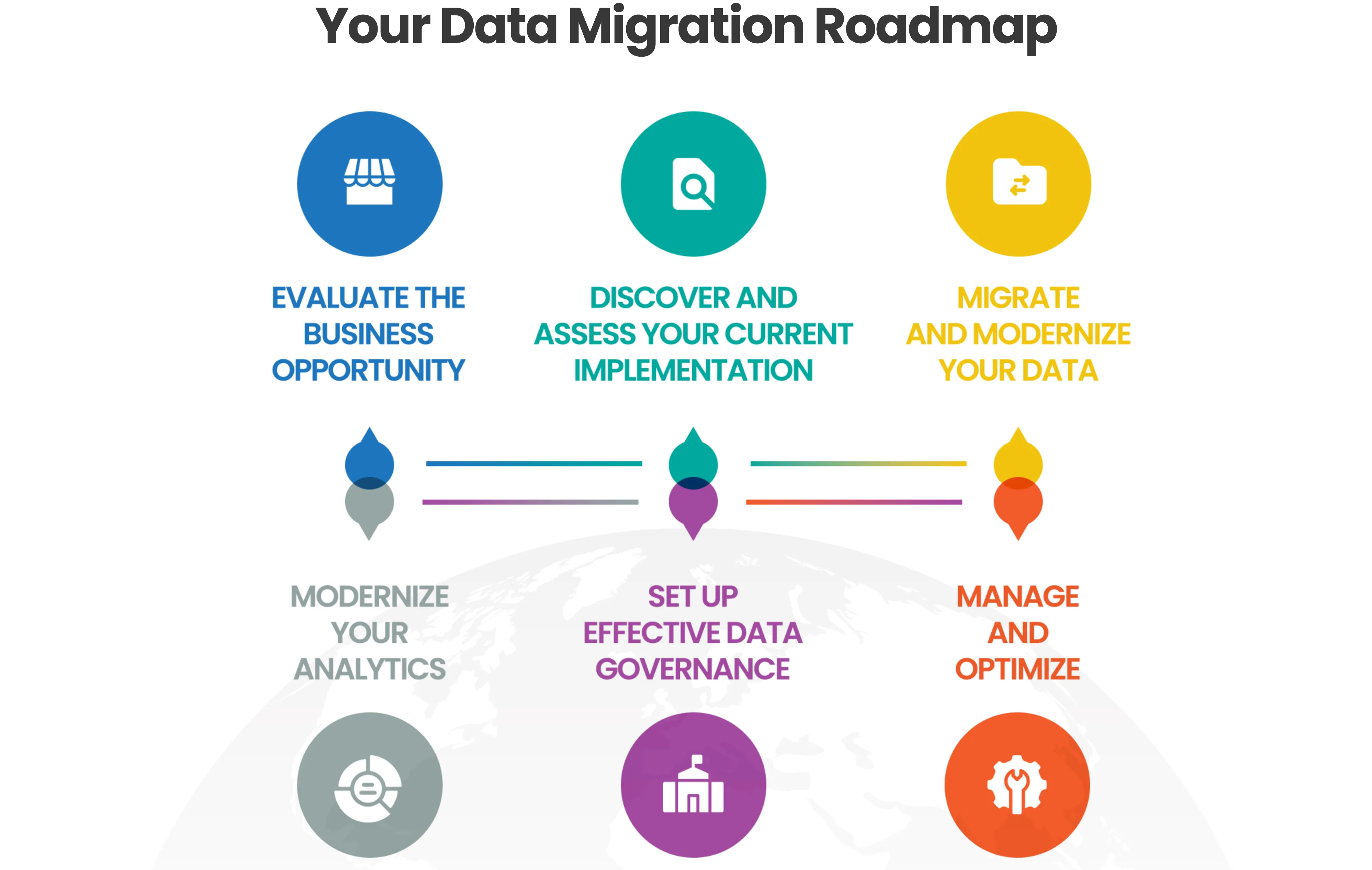Why Are Enterprises Opting for Data Migration to the Cloud?
Enterprises have significant data holdings, yet most of it goes unused. Data is siloed in multiple on-premises repositories and mostly invisible to users. Teams struggle to store and process large data volumes. And users rely on manual dashboards that provide incomplete and lagging indicators of a business that’s transforming in real-time.

Source: Cision
As a result, leaders want to migrate and modernize data to draw valuable insights from their vast data wealth and create connected intelligence that fuels critical business and operational processes. They’d also like to address the challenges they’re currently experiencing with data, which include slow provisioning processes, limited analytics, security and storage issues, and rising costs.
By migrating and modernizing data in the cloud, teams can:
- Deepen data insights: Data and IT can transform data into insight, so business users can leverage it for reporting, analytics, and decision making.
- Enhance security: By migrating data to the cloud, teams can improve their firm’s ability to protect its sensitive data.
- Increase cost savings: Enterprises can increase cost savings by migrating and modernizing data, leveraging modern cloud platforms, which provide storage, workflow, transformation services, and more.
- Improve scalability: Data platforms need to be able to handle vast amounts of data, support real-time processing requirements, and scale up and down as needed.
- Benefit from flexibility: Teams want to share data across applications and with partners over APIs, collaborating on new products and services.
- Strengthen compliance: Enterprises need to future-proof compliance strategies by securing data to meet evolving requirements.
What Is Data Migration?
To get started, let’s define data migration and what this process involves. We’ll also differentiate from similar-sounding, but quite different processes in data conversion and data integration.
According to Tredence and NetApp, key terms to understand are:
- What is a database model? Building a database model is the first step of a migration initiative.
- What is data migration? Data migration is the process of moving data between locations, formats, and systems. It involves such processes as data profiling, ingestion, cleaning, validation, and quality assurance.
- What is data conversion? Data conversion involves developing consistent data formats to ensure interoperability. This may involve saving data in different formats or exporting data in a neutral format and then integrating into desired formats.
- What is data integration? Data integration means combining data from multiple sources into one to create a single view. This often means aggregating and migrating data from multiple legacy on-premises data warehouses into cloud data warehouses or a single data lake or lakehouse.
- What is analytics modernization? Organizations that centralize data in a cloud data lake with a scalable architecture can develop big-data analytics. They can rapidly ingest data, run queries, and solve problems with insights.
Different Types of Data Migration
Data lives at different places. Enterprises may need to migrate data across infrastructures, applications, and data warehouses. As a result, data is the integral part of every organization’s cloud migration strategy.
Let’s take a closer look.
- Platform migration: Data may be migrated during a larger infrastructure migration, such as servers, data storage, and networking hardware. This often occurs when enterprises are virtualizing technology or migrating infrastructure to the cloud. Many enterprises have adopted Infrastructure as a Service (IaaS) to gain cloud scalability and flexibility, while reducing management duties.
- Application migration: Enterprises are migrating and modernizing applications, to get rid of technical debt, adopt new programming languages, and enable faster growth. By modernizing applications in the cloud, firms can connect business processes, improve employee productivity, enhance the customer experience, and strengthen security.
- Data warehouse migration: This typically means migrating an on-premise data warehouse to the cloud, although there may be times when organizations switch on-premise databases or upgrade them.
Data migrations can happen all at once, which is called a big-bang approach, or incrementally, which is called a phased, or trickle approach. These different approaches are discussed more fully below.
Why Choose a Data Lakehouse?
Enterprise teams can choose to migrate their data to multiple destinations – to a data warehouse, data lake, or data lakehouse. While these terms sound similar, they have important differences. Let’s explore them, as well as analyze why a data lakehouse is the best choice for many enterprises today.
- A data warehouse is a repository for storing highly structured data used for decision making and analytics. It provides a relational database, ETL and visualization tools, and AI-powered applications to analyze data at scale. It can live on-premises or in the cloud. Many enterprises are choosing cloud data warehouses because they offer greater elasticity to hold more data.
- A data lake is a huge pool that can store vast volumes of data, including unstructured, structured, and semi-structured data. Data teams assign unique identifiers and tags to elements, enabling users to query only relevant data to solve business problems.
- A data lakehouse combines the best elements of data lakes and data warehouses. According to Databricks, a data lakehouse provides a data management architecture that combines the flexibility, cost-efficiency, and scale of a data lake with the data management and ACID transactional capabilities of data warehouses.

Source: Matillon
Enterprise teams can choose to migrate their data to multiple destinations – to a data warehouse, data lake, or data lakehouse. While these terms sound similar, they have important differences. Let’s explore them, as well as analyze why a data lakehouse is the best choice for many enterprises today.
- Unifies data storage: A data lakehouse integrates structured, semi-structured, unstructured, and streaming data in a single location.
- Real-time data processing: A data lakehouse enables teams to import data from multiple sources in its original format. With integrated, up-to-date data and integrated analytics tools, it’s easier to execute data science projects, use data for business intelligence, and develop AI/ML models for analytics. There’s no more waiting for data to be aggregated and cleaned. Data is integrated and processed in real-time, enabling faster decision making.
- Increase scale and flexibility: Data lakehouses are built for massive scale, enabling you to analyze data from myriad sources, including online customer interactions, financial transactions, call logs and more.
- Reduces costs: It’s more cost-effective to use a data lakehouse that’s built for scale and offers modern analytical tools that operate separate data warehouses and lakes.
- Improved data governance: With unified data governance solutions like Unity Catalog by Databricks, you gain a centralized access to all data, with improved visualization, sharing and security.
- Integrates with analytics tools: Data lakehouses offer analytics tools of their own or users can integrate their own tools to query data and create real-time analytics.
Why Enterprises Need a Data Migration Strategy
You want to innovate faster: developing new business models, products, and services at pace and reaping an outsized share or market spoils. To do so, you need to understand key market trends, such as how customer demand is changing, as well as optimize internal operations, stripping cost, waste, and delay from processes.
By migrating key data sets and modernizing your base model, you’ll be able to develop insights and intelligence that enable you to transform your business more rapidly.
How to Create a Data Migration Strategy
To create a data migration strategy, you need to align around desired goals for data. IT and data teams typically meet with business stakeholders to gain consensus around shared goals; create a vision for using data; and agree on an approach. IT and data teams then develop a plan and roadmap for business approval and secure the budget and resources to begin with.
Some key questions to answer include:
- What business problems are you seeking to solve with data?
- What are your company’s worst pain points with data?
- What’s the gap between your current state and desired future state?
- What’s your vision for how teams use data?
- What data sources are you migrating and where do they live?
- Will you use a medallion architecture to develop high-quality silver and gold data or will you use data domains to speed the race to gold for specific use cases?
- Will you use a data lake or lakehouse to centralize data use?
- What other tools will you use to migrate, modernize, and store data?
- Will you use a big-bang or trickle approach to migrate data?
How a Data Migration Strategy Differs from a Cloud Migration Strategy
A data migration strategy seeks to ingest data from multiple sources, integrate it into a single cloud repository, and transform it for business use.
A cloud migration strategy involves analyzing existing applications and creating a plan for each one. Options include keeping applications on-premise; retiring redundant or unneeded applications; rehosting applications in the cloud (by using a lift and shift approach), re-platforming applications to gain new cloud capabilities; replacing applications with commercially available cloud applications; and refactoring applications by rewriting code in modern programming languages.

What Is a Data Migration Methodology?
Your data and IT teams should follow standard processes to plan and execute data migration initiatives successfully. Key steps in the data migration process include:
Explore Tredence's Exclusive Data Modernization Approach
How to Do a Data Migration
There are two ways to migrate data, either via a big-bang, “one and done” approach or a phased or trickle approach where data sets and workloads are migrated over time. Let’s look at both and why a business might choose one over the other.
- Migrating data using a big-bang approach: With a big-bang approach, teams plan for a large-scale data migration and migrate all critical business data to a odern cloud platform in one initiative. Data teams and partners will spend significant time planning the initiative, to streamline execution and mitigate risk.
With a big-bang approach, data is migrated during a short, focused period of time later in the initiative, after project design and architecture development and testing have been completed. Business users may experience a short period of time where both old and new systems are unavailable, but will be able to access their data after the new system is turned on. Users then test the new system to ensure the migration achieved its goals.
Obviously, this approach has higher risk, which is why planning is so important. However, businesses might choose a big-bang approach if their legacy data platform is reaching end-of-life, creating performance and security risks; they’re losing market competitiveness with current capabilities; or they have use-or-lose investment dollars, among other reasons.
- Migrating data using a phased or trickle approach: With a phased or trickle approach, the overall data migration project is broken down into multiple sub-projects. This enables data teams to execute smaller initiatives to solve the worst data problems and achieve near-term business value.
While a phased or trickle approach reduces the business risk of a major failure, it increases the burden on users as business processes and data will span two systems over a longer period of time.
Popular Data Migration Companies, Tools and Solutions
The data migration market is growing all the time. Here are some of the key vendors that offer cloud migration solutions, data migration consulting services, and other resources like data migration tools that you can use to migrate data.
Cloud Migration
- Atlassian - A cloud migration platform.
Data Lakehouse
- Databricks - A data lakehouse that enables enterprises to unify their data and gain the capabilities of a data warehouse and lake in a single solution.
Data Integration
- Hevo Data - Automates the integration of data from more than 150 sources using a pipeline.
Data Migration
- Tredence, a company that focuses on data science and analytics, offers frameworks, accelerators, and solutions to accelerate migrations, reduce risks, and decrease costs. Our data migration consulting services enable organizations to achieve their goals, such as modernizing data and analytics with cloud and AI capabilities, creating intelligence, and automating processes.
Data Storage
- Object storage – A data storage architecture for storing unstructured data that is provisioned by different cloud service providers as a native service.
Data Transformation
- ATOM.AI - A data transformation platform from Tredence that offers advanced AI/ML capabilities, a pre-built feature set, technical notebooks, deep data sets, and third-party integrations.
- dbt Labs - A data transformation tool that enables data analysts and engineers to transform, test and document data in the cloud data warehouse.
- Fivetran - An automated data movement platform that extracts, loads, and transforms data.
- Talend - Data fabric that combines data integration, data quality, and data governance in a single, low-code platform that works with virtually any data source and data architecture.
Data Workflow
- ControlM – BMC software that orchestrates application and data workflow processes.
- Matillion - A data productivity cloud that provides pre-built data source connectors, loads data and transforms it to make it more consumable for business users.
On-premise and cloud data platforms:
- On-premise data warehouse platforms: Hadoop, Hive, Netezza, Teradata, Cloudera, Exadata, and Hortonworks.
- Legacy cloud platforms: Teradata Cloud, Cloudera Cloud, Oracle Cloud, SAP, and SAS.
- Cloud warehouses: Snowflake.
How Migrating and Modernizing Data Benefits Your Enterprise
You can create game-changing capabilities with the data you already possess. When you migrate and modernize your data in the cloud, you can:
- Increase agility: Data lakehouses and lakes are cloud-based and designed to handle large data volumes. Teams can ingest and process data from multiple sources to populate dashboards for decision making; deploy new ML models to automate processes; and create data-driven, cloud-based products; and scale up and down as needed. Enterprises that migrate and modernize data using cloud platforms create and deploy next-generation cloud-native products 4X faster than before, according to Gigamon.
- Optimize costs: Migrating to a modern cloud platform reduces costs such as hiring staff with legacy programming skills and maintaining outdated platforms. In addition, cloud platforms easily and cost-effectively scale with data growth and enable teams to create analytics that can drive revenues and reduce operational costs. Teams that use a highly efficient cloud operating model that leverages analytics, automation, and AI can achieve annual cost savings of 30%-50%, Gigamon projects.
- Improve organizational efficiency: By storing structured and unstructured data in one platform, you can make it easy to access and process data. Data teams don’t have to aggregate and clean data for use for analytics. They can simply self-serve from a single source of accurate, up-to-date data in the cloud.
- Enhance workforce productivity: Data teams can provision their own data, without needing IT’s intervention. Data lakehouses and lakes have user-friendly interfaces and tools that reduce the need for technical expertise. And data science teams get to focus on analyzing data, rather than ingesting and cleaning it, project by project.
- Increased data security: On-premises data warehouses often represent significant data security risks. One out of every two on-premises system has at least one vulnerability, according to Imperva Research Labs. Organizations may focus on perimeter and endpoint security, over protecting databases and data, according to Imperva. In addition, security teams may not proactively patch critical vulnerabilities, making these data sources an easy target for hackers.
- Improved decision-making: Employees can more easily and securely access the data they need to make decisions or improve processes from anywhere. As a result, it’s easy for business teams to access their own data for decision making. Data science teams can also speed up the time it takes to train data models, run queries on large data sets, and get results in seconds.
Did you know, Data and Analytics Modernization can be your key route to your cost-optimization goals?
Common Data Migration Challenges and their Solutions
Data migration is a complex undertaking, so it’s important to understand key challenges and how to solve them. Challenges during data migration include:
- Failing to prepare adequately: Data migration and data modernization initiatives are complex, so failing to plan properly can cause these initiatives to stall or fail. Teams will want to work through a deliberate process that involves aligning with key stakeholders on project goals, creating documentation on data sources, preparing data, and setting up governance. Taking the time to understand and prepare data, understand and mitigate risks, and setting up sustainable structures for maintaining data quality is essential to creating a long-term program that achieves intended results.
- Experiencing data compatibility risks: Teams typically want to integrate data from multiple sources to get a fuller picture of enterprise performance. That means they need to understand all of the data formats they’re trying to integrate and ensure compatible formats and character encoding, so that like moves into like. Analyzing data sources during planning helps mitigate integration risks.
- Losing data during the migration: The risk of losing data is greatest with big bang systems, which turn off one system, migrate data, and turn on a new one. This risk can be mitigated by backing up data to another location.
- Experiencing data security issues: Migrating data from one location to another can create significant security risks, if this process is not tightly controlled. IT teams should encrypt data before, during, and after it is moved to a new data lake or lakehouse. Other best practices include limiting access to data to only preapproved personnel, using strong authentication controls, and auditing processes for signs of any anomalies.
- Experiencing data security issues: Migrating data from one location to another can create significant security risks, if this process is not tightly controlled. IT teams should encrypt data before, during, and after it is moved to a new data lake or lakehouse. Other best practices include limiting access to data to only preapproved personnel, using strong authentication controls, and auditing processes for signs of any anomalies.
- Experiencing data security issues: Migrating data from one location to another can create significant security risks, if this process is not tightly controlled. IT teams should encrypt data before, during, and after it is moved to a new data lake or lakehouse. Other best practices include limiting access to data to only preapproved personnel, using strong authentication controls, and auditing processes for signs of any anomalies.
Data Migration Best Practices
Here are some best practices to streamline your data migration journey and move forward in a disciplined manner.
- Conduct a thorough migration assessment: During the assessment phase, you will create a vision for data migration, including why it’s required; quantify benefits; identify risks and mitigation strategies; and understand technical requirements to prepare data and migrate it to its new location. This process will involve identifying all of the vendors, tools, and platforms you will be using.
- Isolate production systems: Once the data migration is complete, your teams should test data with less important systems, isolating business-critical systems. Then, when you’ve decided that the data is accessible, accurate, complete, you can switch over key business systems.
- Complete system upgrades before migrating data: If original systems or new applications need an upgrade, you should do so before beginning the migration process. This reduces project complexity and the risk of creating data compatibility or other errors
- Establish a data migration timeframe: Partners can help you accurately scope the migration initiative, including setting appropriate timelines. Enterprises that use accelerators can significantly increase the pace of data migration initiatives.
- Validate and test data post-migration: Ensure that data performs as expected, and that no issues such as data compatibility errors or data loss have occurred.
- Audit processes at every step: Keep projects on track and proactively mitigate risk by auditing processes and systems, even after data has been successfully migrated.
Choosing the Right Data Migration Services Partner
Partners can increase value with data migration workloads by supporting strategy-setting and identifying high-value data workloads to migrate to the cloud. They also can deploy a modern data platform, such as Databricks or Snowflake that’s optimized, secured, and automated.
A partner should:
- Have demonstrated cloud migration strategy and execution experience, developed over dozens of engagements.
- Have a deep bench of data engineers, data scientists, and cloud migration specialists to guide work.
- Possess technical expertise in data migration, data modernization, and analytics modernization, as well as all leading hyperscale cloud platforms and cloud data lakes and warehouses.
- Have strong partnerships with firms such as Amazon AWS , Microsoft Azure , Databricks and Snowflake.
A partner can add value by:
- Providing end-to-end data migration and data modernization services.
- Offer dozens of accelerators, including industry-focused solutions and tools.
- Provide well-honed industry use cases to solve entrenched problems fast.
- Increase value with a data migration center of excellence, partner orchestration, and program management.
- Offer a co-innovation platform to develop and scale new processes.

Data Migration FAQs
So, which enterprises benefit most from data migration and how should they do it? Read our FAQs to learn more.
Enterprises migrate data for a variety of reasons. Two major reasons to migrate data include creating analytics to power the business and a desire to maintain market competitiveness. Other reasons include a desire to gain cloud scale and flexibility, exit the data center business entirely, decrease operational costs, strengthen security, and enhance business resilience and continuity. Many enterprises have end-of-life data platforms that represent significant business and security risks if not replaced with cloud capabilities.
Enterprises can migrate data on their own. However, many leaders prefer to tap the expertise, tool, and services of a partner to migrate and modernize data at speed and scale. This enables enterprise data and IT teams to focus on other objectives, such as developing machine learning models, creating connected intelligence, and evolving the corporate network.
If you choose to work with a partner, the process can begin as simply as scheduling a consultation call to explore business opportunities. A partner can help you determine which data sets and workloads to migrate and modernize your base model.
Absolutely! Your team can control what data gets migrated and modernized. However, the business value that you create will be driven by how many data sets and workloads you move over. Most enterprises choose to move over a critical mass of business data used for processes such as developing products, optimizing the supply chain, and improving the customer experience.
If you work with a partner that has deep domain expertise, fit-for-purpose tools, and partnerships with hyperscalers, you can migrate data within months.
Enterprises maintain ownership and control over their data, while data lake and warehouse providers own and control the infrastructure supporting it. That means that enterprises can migrate data to the cloud and also remove it from the cloud.
Many enterprises choose to migrate data to Snowflake or Databricks, which are market-leading platforms. They choose their platform based on their needs and requirements. Snowflake is the most efficient platform for SQL and ETL operations, while Databricks is well-suited for industry use cases involving data science, machine learning models, and analytics.
It is always wise to review the cloud data security your data lakehouse provider offers. Snowflake offers dynamic data masking and end-to-end encryption for data in transit and at rest stored in its Data Cloud. Databricks offers encryption at rest, network controls, data governance, and auditing.
Work with a Leading Data Migration Consulting Services Partner
You can accelerate your journey to the cloud with Tredence data migration and data modernization services. We will help you create connected intelligence, empower teams to make decisions, and develop predictive capabilities that continuously unlock new value.
Tredence can help you achieve:

We’ll help you explore new business opportunities that can drive new ROI in months.





